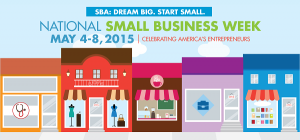6 Things Entrepreneurs Need to Know—Small Business Week Edition
By Rieva Lesonsky
In honor of Small Business Week, we’re bringing you three bonus editions of Things Entrepreneurs Need to Know. Be sure to check the regularly scheduled column, which posts here almost every Saturday.

National Small Business Week Special Report
1) Small Business Optimism Soars
According to the 2015 Capital One Small Business Confidence Score, an analysis of small business sentiment data collected by the Spark Business Barometer, small business optimism is at its all-time high since the Great Recession. The survey says small business sentiment is up 33 percent since 2009 (following the depths of the Great Recession) and continues to improve in 2015.
But says Keri Gohman, head of Small Business Banking at Capital One, that doesn’t mean small business owners are problem-free. “Competing and growing in today’s increasingly competitive and complex digital landscape can be tough,” she says, “particularly for small businesses with limited funds, resources and time. Our goal is to make some of those resources more accessible, so small businesses can grow and succeed.”
One of the biggest challenges small business owners face is attracting and retaining customers. The Capital One Spark Business shows 76 percent of business owners face marketing challenges, with 39 percent claiming they have not executed any marketing initiatives in the past six months. Some of the other specific challenges include:
- Identifying and reaching new customer prospects: 41 percent
- Finding money to market their business: 32 percent
- Gaining attention due to local competition: 18 percent
- Getting advice on the best marketing approaches: 18 percent
- Customer retention: 17 percent
Plus, over 64 percent of small business owners think they’re unable to effectively market their businesses the way they’d like. And though nearly 70 percent say they would designate extra funds toward marketing efforts, only 8 percent have a mentor who can offer the necessary insight or strategic direction to help them do so.
To bridge this gap, Capital One and Pacific Community Ventures have partnered to launch BusinessAdvising.org, an online mentoring platform matching small businesses located in or hiring from low-income communities with expert advisors in areas such as marketing, technology, finance, and more.
As part of this partnership, Capital One will also provide associate volunteers to serve as small business advisors. The launch of BusinessAdvising.orgis part of Capital One’s $150 million Future Edge initiative, designed to help individuals and entrepreneurs succeed in today’s digitally-driven economy. To further support the Future Edge initiative, Capital One is investing an additional $500,000 in low-interest loans to Pacific Community Ventures to help expand their lending efforts to microbusinesses across California.

2) Americans Have “Big” Ideas about Shopping Small
An overwhelming number of consumers—92 percent—support small and medium-sized businesses in their communities by patronizing these establishments at least once a week, according to the 2015 Cox Consumer Pulse on Small Businesses. In fact, 63 percent visit a small business at least three times a week.
Most—71 percent—buy from small businesses simply because they want to “buy local.” Other reasons to shop small were convenience (61 percent) and higher levels of customer service (54 percent).
Although most of the consumers were happy to shop small, they do have some advice for local entrepreneurs:
- Offering more competitive pricing: 53 percent
- Offer loyalty programs: 43 percent
- Expand hours of operation: 32 percent
- Broadening your offerings: 24 percent
- Offer free Wi-Fi: 20 percent
If you want to reach these consumers—email is their preferred way to hear from you. Here are the numbers:
- Email: 53 percent
- In-person events: 48 percent
- Social marketing: 45 percent
- Direct mail: 32 percent
- Texts/SMS: 18 percent
- Phone: 7 percent
For years, I’ve been advocating teaching entrepreneurship in grade school, and apparently America agrees. Nearly 80 percent of those surveyed think entrepreneurship and small business ownership curriculum should be offered covered in K-12 education—and half think these classes should begin before high school.
Nearly 80 percent of consumers think the federal government should do more to promote small business growth and 66 percent also say local government agencies are falling short in this area. More consumers (41 percent) think Democrats do more than Republicans (32 percent) to support small businesses.
Check out the complete findings from the 2015 Cox Consumer Pulse on Small Businesses and more details can be found on CoxBLUE.com.
3) How Hard is it Really to be an Entrepreneur?
The answer to that question, as if you didn’t know, is “extremely hard,” or so says a new survey Constant Contact. The sacrifices are considerable: 56 percent of small business owners feel like they can never be away from their businesses and 51 percent say they don’t have time to focus on themselves.
Yet, the rewards are considerable—and highly personal. A combined 59 percent cite having the freedom to try new things and make their own mistakes, or controlling their destinies are the best parts of being a business owner and 84 percent would do it all over again.
In addition to feeling tethered to their businesses and having no time for themselves, small business owners say:
- They don’t take vacations: 43 percent
- Have their money tied up in their businesses: 41 percent
- See family and friends as much as they would like: 40 percent
What are the most difficult aspects of being an entrepreneur?
- Having to wear so many different hats (43 percent)
- “Riding out bad economic times” (20 percent)
- Hiring and managing a staff (10 percent)
Their top business concerns are:
- Finding new customers: 66 percent
- Having enough time to do everything I need to do: 55 percent
- Retaining existing customers: 40 percent
- Paying my bills: 32 percent
- Keeping up with technology: 30 percent
Given all of the challenges, both personal and professional, the big question is, “Why do they do it?”
- Ability to pursue my passion: 62 percent
- Freedom to control my professional life: 59 percent
- Flexibility: 50 percent
- I don’t want to work for anyone else: 41 percent
In honor of Small Business Week, and in recognition of just how hard the job of a small business owner can be, Constant Contact has curated the best pieces of business advice received from small businesses, influencers, and more. Click here to view the advice. <<link to SlideShare>>

4) Security Threats
The 2015 Internet Security Threat Report from Symantec, the maker of Norton, shows 60 percent of all targeted attacks struck SMBs last year.
Highlights from the ISTR include:
- SMBs saw an uptick in spear-phishing attacks last year, with attacks increasing 26 percent and 30 percent, respectively.
- Attackers became more precise, using 20 percent fewer emails in spear-phishing campaigns to successfully reach their targets, and incorporating more drive-by malware downloads and other web-based exploits.
- Sales and marketing divisions at companies of all sizes are the most at-risk. Thirty-five percent of personnel were targeted by spear-phishing in 2014.
The ISTR is Symantec’s largest annual research report that provides an overview and analysis of the past year in global threat activity, including emerging trends in attacks, malicious code activity, phishing and spam. You can view ISTR assets here, including videos, infographics, segmented data and blog posts.
5) It’s All Personal
We all want to improve our entrepreneurial skills. But workplace author, speaker, columnist & consultant Alexandra Levit, whose current work can be found in The New York Times, believes small business owners can best hone their entrepreneurial skills by improving their personal reliability. Here are her six tried-and-true tips:
1- Think Before You Promise
You want to help, so when someone asks you for something, your immediate reaction is “Yes, of course!” But there are only so many hours in the day, and if you say yes too much, you won’t have time for the important things. The next time you’re pinged, take a step back and objectively consider whether you have bandwidth to make good on the promise. Saying no now is far better than breaking your word later.
2- Don’t Overbook Yourself
To the point above, entrepreneurs and small business owners are usually pressed for time. Don’t make things worse by scheduling multiple meetings on top of each other—especially if they are in different locations! You are just asking to get stuck in traffic, at the airport, or even on the phone—leaving others hanging.
3- Plan for Deadlines
Most people don’t miss deadlines on purpose. They miss them because the task takes longer than they expected and they run out of time. Avoid this problem by plotting exactly what you’ll accomplish on a given project every week. You’ll be able to see well in advance if you’re running behind schedule and can make adjustments accordingly.
4- Ask for Help
Many owners get into jams because they think they are superheroes and can do everything themselves. They don’t routinely delegate and they can’t admit when they’re under water. Realize that calling on extra resources so that you don’t have to sacrifice your reliability is a sign of maturity, not weakness.
5- Invest in the Right Technology
Investing in the right technology products and solutions can simplify your life and help you work faster and smarter. The three pieces of technology essential to an efficient home office include a svelte laptop with unlimited storage, an external hard drive to ensure all of your files remain intact, and a high-speed and cost effective printer, such as a Canon MAXIFY. You won’t realize how much you need a good printer until you don’t have one.
6- Be Honest About Foibles
No matter how hard you try, there are going to be times when you just can’t come through. Instead of trying to sweep a lapse under the rug or pretend a deadline never existed, own up. Sincerely apologize and rectify the situation as best you can. As long as it doesn’t become a habit, people will understand.
6) Where’s Your Money Going?
Recently, office electronics manufacturer Brother released its 6th annual Brother Small Business Survey, showing, among other findings:
54 percent of small business owners surveyed would prefer to invest in their businesses—rather than stockpiling cash—an 18 percent swing in preference since 2010.
33 percent are looking for ways to leverage the Internet of Things.
67 percent want to invest in making a tech change this year (and the results indicate they should aim to invest more in cloud computing).








